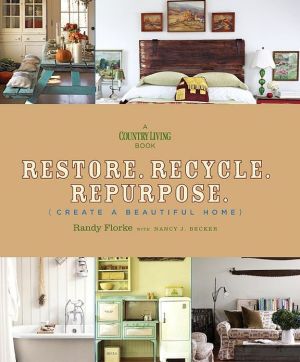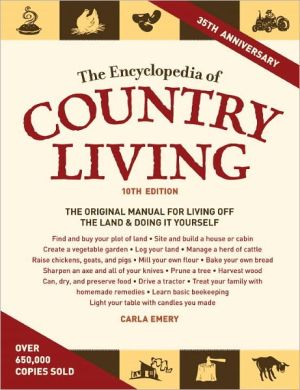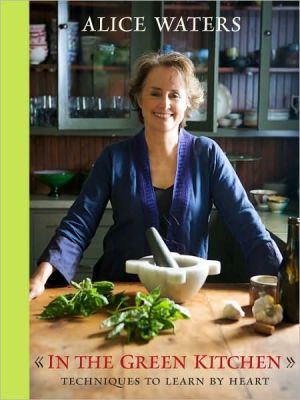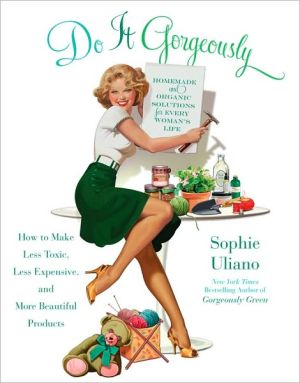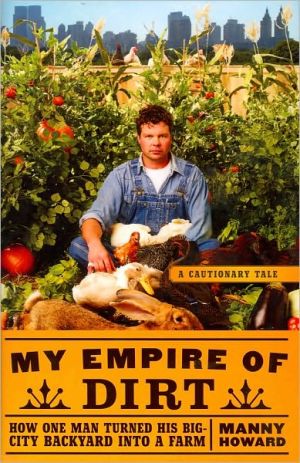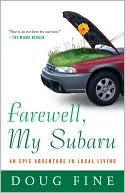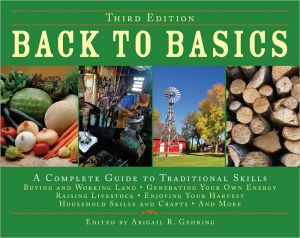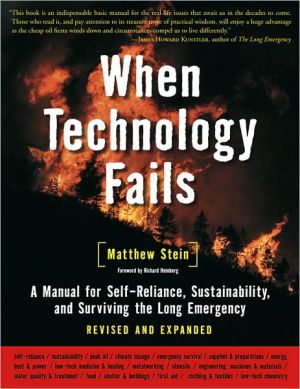Sara Snow's Fresh Living: The Essential Room-by-Room Guide to a Greener, Healthier Family and Home
In this easy-to-follow guide, the green-living expert and host of the popular TV shows Living Fresh and Get Fresh with Sara Snow offers busy families simple, affordable ways to create a healthy, environmentally friendly home—room by room.\ \ Every day, families make countless consumer choices, from which diapers to use to which apples to buy, to whether their next car should be a hybrid. For new parents concerned about the future of their children—and of the planet they will leave them—being...
Search in google:
In this easy-to-follow guide, the green-living expert and host of the popular TV shows Living Fresh and Get Fresh with Sara Snow offers busy families simple, affordable ways to create a healthy, environmentally friendly home—room by room.Every day, families make countless consumer choices, from which diapers to use to which apples to buy, to whether their next car should be a hybrid. For new parents concerned about the future of their children—and of the planet they will leave them—being informed feels especially urgent. But in the midst of a booming natural and organics industry, the many options can make easing into living green confusing. Now Sara Snow offers practical solutions for every aspect of family life, from laundry to recycling to decorating the nursery. Discover ways to green…• your kitchen with healthier foods and safer cooking and storage options• your bathroom with recycled toilet and tissue paper and nontoxic cleaning supplies• your bedroom—and your love life—with chic eco-friendly bedding and sexy personal products• your yard with a rain barrel attached to your gutter downspout to reduce runoff, prevent erosion, and capture clean water for your flowers, vegetables, and lawnAnd there’s much more to inspire and encourage you, from advice on introducing children to healthy eating, to products and foods for your animal companions, to chemical-free gardening—plus sidebars offering insider secrets from green-living pioneers. Here is an invaluable resource for anyone who wants to do something positive for the well-being of their family, whileleaving a lighter footprint on the world. Publishers Weekly Writer, speaker and Discovery Channel television host Snow sweeps through each room of the house (and the yard) in this overview of effective green living strategies new and old-Snow grew up a sustainable lifestyle, so has deep roots in eating healthy, composting and recycling. In the kitchen, Snow reviews choices that protect health and the environment, from ingredients and labeling to water conservation and responsible shopping. In the living room, she advocates houseplants for clean air and energy conservation; outside, issues include green transportation options like bicycles, nontoxic lawn care and gardening. Snow tips off readers to products, like particleboard furniture, that release volatile organic compounds within the home, reviews an easy-to-assemble housecleaning tool kit and even touches on green funerals, but never gives readers specific brands to seek out or avoid-meaning they'll still need to research their own options (no websites are recommended either, aside from Snow's own). Though a thorough overview, Snow's guide offers little new, especially compared to similar offerings such as National Geographic's Green Guide; Neophytes may find this a good starting point, with plenty of easy-to-digest information, but a lack of specificity may frustrate. Copyright © Reed Business Information, a division of Reed Elsevier Inc. All rights reserved.
My Story\ My unusual upbringing and family story are fundamental to who I have become. These days, what fuels my passion and activism are not only the changes I see happening in the world around me, but also the way I was raised and the environmental lessons my parents taught as I was growing up.\ For this reason, any time I speak to an audience, whether through television or on stage, whether I'm talking about ways people can create healthier homes or how businesses can green their practices, I always start out with a primer on my upbringing. And the first line of my story is almost always “I grew up in a home that was different from most.” But I started wondering one day if I was exaggerating. Maybe most people's homes were a little like mine, and they lived off the land the way I did growing up. When I tell the story, I'm not trying to imply that my family's lifestyle was better than everyone else's, just that it probably was different, and, in truth, it was likely more sustainable. And though it was also rough and tough in many senses, we were doing our best to live in a low- impact way and in tune with nature, or to be “harmonious” with the world around, to use a family term.\ In the pages that follow, you'll learn about all that, but you'll also discover that as I grew older I fell off the eco trail for a short while. I didn't intend to, but it didn't take long before I could feel the difference, and it was the process of getting back on track that proved ultimately to be my most valuable lesson. I learned a lot about myself, and about how to get back to a more natural state of living, about what works and what in particular is easy for people who are just starting out and moving toward greener, more natural living.\ I also learned that there is no such thing as perfect.My parents weren't perfect, I'm certainly not, and I won't ever expect you to be. Choosing to live more sustainably isn't one- size- fits- all and it's not all- or- nothing. It's about a series of small steps and changes toward greater health and harmony. I was lucky;my parents started taking those steps before I even came into this world.\ My Upbringing\ I was born at home, in my parents' bed. There weren't many naturopathic Ob/Gyn's at the time, and home births were not very common, but my parents found someone they trusted-someone who would make house calls and home deliveries-so that our first breaths wouldn't be in the sterile environment of a hospital. My older brother took a long time to come into this world. Dr. Vander Yacht napped on the couch off and on for the final six of the twenty- six hours that my mom labored. About two years later I was a little quicker, but without any meds at all my mom felt every moment of my birth. At the time, we were living in a small house in downtown Ann Arbor, Michigan. Ann Arbor, home to the University of Michigan, is a town made up of educated, liberal nature lovers. Not everyone there fits this snapshot, of course, but with over one- quarter of city residents employed by the university, definitely more so than average. The city is known for, among other things, an internationally recognized art fair and the “Hash Bash,” during which possession of marijuana used to be punished only by a five- dollar fine. (The fine has since increased considerably.)\ And it was into this offbeat Ann Arbor community that I was born. At the time, in July of 1976, my parents were already deeply involved in the booming natural products and natural foods movement, a movement that would later help birth the “green movement” of today. My dad, Tim Redmond, was raised in Birmingham, Michigan, an affluent suburb of Detroit, as the younger of two sons of a successful businessman. His dad, my grandfather, had founded a company dealing in industrial rubber in the auto capital of the world, Detroit, prior to the Second World War. He and my grandmother and the two boys lived quite a comfortable life in the postwar years. My dad went to college to study business but came out with a degree in English literature and education. So after college, rather than taking over his father's business, which would have immediately provided a certain level of prominence and comfort, Tim announced to his much- chagrined father that he wanted to “do his own thing” and that his intentions were to save the world . . . through food.\ My mom, Pattie, was the daughter of an accountant/economist and a nursery school music teacher. For most of his career, my maternal grandfather worked for U.S. Steel in New York City. My mother grew up with two sisters in a home in Princeton, New Jersey, where dinner table conversations centered on serious matters like religion and politics, punctuated by a lot of girlish giggling. Pattie followed her older sister Judy to Ann Arbor in 1970 when Judy needed a nanny and my mom needed a break from college. It didn't take long for Pattie's and Tim's worlds to intersect on the city sidewalks of Ann Arbor.\ Around this same time, a Japanese man named Michio Kushi was be - ginning to teach about a lifestyle and food practice called macrobiotics. Macrobiotics is a Greek word meaning “great life” or “whole life” and was first used by the father of medicine himself, Hippocrates. Kushi's mentor George Ohsawa, the founder of macrobiotics, had in the early 1900s used a regimen of holistic living and pure, natural foods to cure himself of lung tuberculosis. He became resolute in his belief in the power of whole and living foods, and went on to teach others about this practice that he called macrobiotics. Ohsawa believed there was a second layer to “food is health,” and that is that “health is the key to peace.” He thought that if we could all return to a traditional diet of whole and natural foods, humanity would become more peaceful by reclaiming our physical and mental balance. Michio Kushi and a few of George Ohsawa's other early followers took his teachings to Germany, France, Brazil, and the United States.\ And this is where I (or my parents) come back into the picture. Around the time my dad was making the announcement about his intentions to save the world through food, he was spending time in Boston training under Michio Kushi, learning the principles of macrobiotics and natural foods. Tim came back to Ann Arbor in 1970 and, in the entrepreneurial fashion of his father, cofounded a macrobiotic natural food business called Eden Foods. (One of his buddies and Eden cofounder at the time, coincidentally, was Mark Retzloff, who later went on to cofound Horizon Organic Dairy, the company that first brought organic milk to America's food stores.) Eden, now an internationally respected name in the organic food business, started off as a simple natural- foods buying club, then grew into a retail store, and grew again into a distributor and processor. In step with increasing demand from the burgeoning number of young back- to- the- landers and readers of Stewart Brand's Whole Earth Catalog and Robert Rodale's Organic Gardening magazine, my dad forged relationships with farmers and food producers who were growing and processing whole and natural foods that were synonymous with the macrobiotic diet. In the early 1970s, well before organic farming on a commercial scale really existed, my dad and his group had a vision for a company based on sustainable agriculture and the distribution of natural foods: whole grains, stone- ground flours, unfiltered oils, beans, seeds, nuts, sea vegetables, and other unprocessed, unrefined foods. “Real” foods, they called them. Their vision was to change the way America eats-to get Americans off Twinkies and Coca- Cola, and to create a better world through healthier living. At first there was just a co- op of people who wanted these foods, but that quickly changed and Eden Foods grew in 1976 to include a distribution warehouse and small fleet of trucks, located outside of town, and a restaurant and storefront in downtown Ann Arbor. My mom, by now married with a toddler and another (me) on the way, worked alongside my dad and honed her green thumb growing organic sprouts in the basement at home for our store and a few others around town.\ And then I came into the world, making our little green family a foursome, and growing the Eden family business by another. My dad's original partner was his brother- in- law, and as the little company grew, the people working there generally related to each other as brothers and sisters and peers. We lived near one another, shared meals together, and played together as kids. Nate, my brother, smart for his years already at age six, was manning the register at the store, making change for customers. I had it much easier. I rooted raisins out of barrels, ordered up the “daddy's special” sandwich (a hand- fired whole wheat chapatti filled with hummus, Muenster cheese, cucumbers, and sprouts and sprinkled with Herbamare-a sea vegetable, herb, and salt mixture) in the deli, and wagged my chubby little fingers at the customers who came in to stock their healthy kitchens.\ Our family was a good illustration for healthy living, yet every now and then meals of brown rice and vegetables were punctuated with a pint of Häagen- Dazs ice cream, a heavily sugared dairy food considered unbalanced and extreme in the macrobiotic diet. I imagine my mom and dad, still very young, in their kitchen with the curtains drawn, enjoying this infrequent guilty pleasure. While the ice cream itself was unbalanced and too “yin,” having an occasional bite or two of forbidden fruit allowed them to live with balance, something very important in any naturalist's lifestyle.\ Our Home\ A few more years into this life, my parents wanted to have more children, and were starting to form a vision that involved raising their family in the country, with fewer modern conveniences but a greater connection to nature and the simplicity and freedom that it could bring. My mom's two sisters and their husbands, both involved in some capacity with natural foods and getting back to the land, were living in or near Ann Arbor at the time. One of her sisters decided to go in on a plot of land with my parents and my mom's parents, just recently moved to Ann Arbor from Princeton. My uncle David was a builder, so he and his team built the three passive solar, energy efficient, native white cedar-sided homes, on a cleared section of about twenty acres, with a lake and twenty- five more acres of woods and meadows surrounding. We were less than thirty minutes outside of Ann Arbor, but it seemed we had found a little piece of wilderness, just a marathon's distance from city life. My aunt and uncle and their kids moved into one house on the lake, and my grandparents moved into the other. We-my dad, mom, brother, and I-lived in the third house, on top of a small hill, just a short walk's distance from the other two homes. Eventually, two kids became four in our family, when my brother Joe was born a year or so after we moved in and sister Elizabeth followed four years after that.\ If my upbringing wasn't already much different from your own, here are where the standout differences begin. We spent weekends in a small pop- up camper while we were building our home so we could all pitch in during the building process, and finally moved into the house when it had four walls and a roof. A ramp stood in for a lower set of stairs, a front door wasn't added until months later, the indoor plumbing wasn't fully operational the first month or so, and yet it was home. The house was a tri- level with a woodstove inside and solar hot water panels on a south- facing hill outside. The first floor consisted of my parents' bedroom, a bathroom, the kitchen, and, off the sitting area, a connected greenhouse on the south side of the house. The floors were solid hardwood, as was the beamed ceiling, and there were rough twelve- inch- square oak posts that went from the floor to the ceiling. The kitchen and sitting area were the heart of our home-with the woodstove serving as the main source of heat through years of harsh Michigan winters. The second level had a living room and wood- paneled den, and upstairs there was a bath, a big bedroom, an open reading area, and an office. The single bedroom became two bedrooms once Joe was born, and the office eventually became a third after Elizabeth joined us. It felt huge, spacious, and airy to me, but it wasn't so big at all compared to today's overblown standards or even a typical suburban home of the time.\ The greenhouse was constructed of a glass roof and sloped glass walls. It served two important functions: a place to sprout plants from seeds so they could grow before being transplanted into the vegetable garden, and the second source of heat. Without a furnace, we relied on the woodstove and the collected solar heat from the greenhouse to keep us warm when the temperature outside dropped. In the colder months we would keep the door between the house and the greenhouse closed until midmorning, when the sun had been up for several hours and heat had started to gather in the greenhouse. I remember as a child watching the thermometer on the other side of the sliding glass door until it rose to a temperature higher than that of the house, indicating that it was time to throw open the door and let the heat flood in. Of course, as the sun began to dip down and the greenhouse was no longer warm, the door would be closed until the same time the next day. The most phenomenal part is that my parents designed the house so that even if it was only 2 degrees Fahrenheit outside, the sun's rays shining into the greenhouse would generate enough heat to flow into our home and keep us warm. In the summer months, because collecting the sun's warmth was not what we wanted, we draped a white canvas over the greenhouse roof to keep the heat from accumulating.\ Our kitchen was stocked with healthy, unprocessed foods, mostly items my dad brought home; some of the rest we grew ourselves in one of our many gardens. My mom's primary focus, now with four kids and a home away from city conveniences, was raising a family on the most nutritious and simple foods possible in a nurturing, healthy environment. Dinners in the summer came mostly from the organic gardens. Everything from potatoes, greens, and corn to currants, melons, and herbs came from these gardens. We ate like kings and queens from late spring through mid- fall, and froze and jarred extras through the plentiful months so we could enjoy the just- picked freshness (and nutritious qualities “fresh” frozen can have) even after a chill set in.\ With my cousins living just down the hill and my grandparents only a few steps farther away, it was a family affair of the best kind. We lived in a secluded family community where we could run barefoot from house to house, swap cucumbers for beets when one harvest was especially good, take picnics in the woods together, and ski through endless wooded trails in the winter. It was “simple” living at its finest.
\ Publishers WeeklyWriter, speaker and Discovery Channel television host Snow sweeps through each room of the house (and the yard) in this overview of effective green living strategies new and old-Snow grew up a sustainable lifestyle, so has deep roots in eating healthy, composting and recycling. In the kitchen, Snow reviews choices that protect health and the environment, from ingredients and labeling to water conservation and responsible shopping. In the living room, she advocates houseplants for clean air and energy conservation; outside, issues include green transportation options like bicycles, nontoxic lawn care and gardening. Snow tips off readers to products, like particleboard furniture, that release volatile organic compounds within the home, reviews an easy-to-assemble housecleaning tool kit and even touches on green funerals, but never gives readers specific brands to seek out or avoid-meaning they'll still need to research their own options (no websites are recommended either, aside from Snow's own). Though a thorough overview, Snow's guide offers little new, especially compared to similar offerings such as National Geographic's Green Guide; Neophytes may find this a good starting point, with plenty of easy-to-digest information, but a lack of specificity may frustrate. \ Copyright © Reed Business Information, a division of Reed Elsevier Inc. All rights reserved.\ \ \ \ \ Library JournalSnow is an engaging ecological evangelist, preaching green goodness for your home. Her text is highly informational, brimming with well-researched facts. Whether you are fully converted to a green lifestyle or just want to cherry-pick some easy changes, this book speaks to all levels.\ \ —Karen Ellis\ \

